Chapter Four
Panzerwaffe Backbone – Ausf G–H
The next two production models, the Ausf G and H also armed with the KwK40, formed the bulk of the Mk IV panzer force, with 1,687 Gs and 3,774 Hs built during 1942 to 1944. From 1943 panzer divisions were meant to have one battalion equipped with Mk IVs and one with Panthers, but due to problems with the latter this often did not happen. The net result was that there were always more Panzer IVs than Panthers. Most of the Ausf G went to Russia while in 1944 most of the Mk IVs in France were Ausf H supplemented by Ausf J.
Ausf G
The Panzer IV Ausf G first went into production in May 1942 and was initially armed with the same main gun as the interim F2. Visually there was very little to distinguish the two. Notably, on the G model the vision ports on the sides of the turret were dispensed with as well as the one serving the loader’s position on the front of the turret. By the summer of 1942 other alterations included a new muzzle brake and a system that permitted siphoning coolant from one panzer to another to help coldweather starting. The smoke dispensers were also moved from the rear of the hull to the turret sides.
It was very quickly decided to up-armour some of the G model. From 20 June 1942 deliveries included additional 30mm armour plate bolted or welded to the front of the hull and superstructure. This gave the tank a total of 80mm on the front. It had been hoped to boost it to 100mm, but trials showed the Ausf G became too nose heavy and difficult to steer. From July to November 1942 every month some sixteen production tanks were fitted with the additional protection. From December 1942 the number went up to 50 per cent of all production tanks which resulted in about 700 Ausf G having the extra armour.
At the beginning of 1943 the driver’s KFF2 episcope on the Ausf G was removed. Also that year spaced armour consisting of thin steel plates or panels hung from steel brackets, known as Schürzen or skirts, were added to the sides of the hull and the sides and rear of the turret in response to a fresh Soviet threat. Hence the removal of the turret’s side vision ports. To allow the turret side access doors to open hinged double doors were fitted to either side of the 8mm turret skirts. Despite these it was possible to escape via the turret without using the doors in the spaced plates.
The 5mm hull Schürzen consisted of six plates either side with the front two and the rear one tapered. The foremost was the smallest and created a greater taper than at the back, but this was easily damaged and often absent. These skirts covered the hull and superstructure, the return rollers and a quarter of the drive sprocket and idler. The eight road wheels were left exposed.
Made of mild steel boiler plate, the Schürzen were intended to help defend the tank against attack from the new Soviet RPG-43 shaped-charge high explosive anti-tank (HEAT) hand grenade and later hollow-charge weapons such as the American Bazooka and the British PIAT (Portable Infantry Anti-Tank). The RPG-43 entered service in 1943 and could penetrated 75mm of armour at a 90º angle. Although it had to be thrown at very close range, it gave no warning like other anti-tank weapons. The skirts would prematurely detonate an incoming projectile inches in front of the main armour and dissipate the force of the HEAT round. Although the plate would be destroyed, it saved the tank from direct impact. The hull Schürzen were fragile and easily damaged in combat or torn off whilst the tank was on the move. As a result the additional turret skirts tended to last a lot longer. Panzer IV were regularly photographed with the hull Schürzen in varying states of disrepair with sections of plate missing.
Another form of protection was added from early 1943. This was a light grey paste known as Zimmerit, which was applied to the vertical surfaces of the hulls and turrets of most tanks and assault guns. Panzer IVs were coated in the factory before painting and the paste was raked with a spreader, creating ridged and criss-cross patterns to increase the depth. The paste was then hardened off and spray-painted. This prevented the attaching of magnetic anti-tank hollow charges. On occasion the Schürzen were also coated in it. The Zimmerit patterns varied from factory to factory.
Final production Ausf G were fitted with a new type of drive sprocket and the radio antenna was moved from the right of the hull rear to the left. The later alteration made it impossible to distinguish late Ausf G from early Ausf H. The new design sprocket wheel was intended to improve traction with the tracks. Mid-model Ausf G were fitted with a double-baffle muzzle brake on the main gun used on the subsequent H and J models.
A total of 1,275 Ausf G were armed with the KwK40 L/43 gun. Then from late March 1943 the Ausf G followed by the H and J were armed with a gun with an even longer barrel, the 75mm KwK40 L/48. Although this fired the same ammunition as the 43-calibre gun, it had a barrel five calibres longer. The breech mechanism was also simplified to help with production. Nonetheless, apart from a few components, the barrel and breech rings of the 43- and 48-calibre guns were interchangeable.
Production of the Ausf G ended in June 1943. In total ten separate orders with Krupp-Gruson, Nibelungenwerke and Vomag amounted to 1,750, but only 1,687 were built as Ausf G. The rest were employed as prototypes for the Hummel (Bumble Bee) and Brummbär (Grizzly Bear) consisting of ten and fifty-three chassis respectively. When Hitler’s summer offensive commenced on the Eastern Front in June 1942 he had about 170 F2 and G available. By the start of the Kursk offensive the following summer Army Groups Centre and South had 841 long-barrel Panzer IVs.
Ausf H
In early 1943 General Heinz Guderian was appointed Inspector-General of Armoured Troops. He was not impressed with the new Panzer V dubbed the Panther, which was having unending ‘teething’ problems. He recalled, ‘In the tank production field it was decided during April, in accordance with my suggestion, that the Panzer IV should continue to be built until such time as a high level of mass-production was absolutely assured for the Panther.’ Later in the year Guderian was very displeased to learn that Panzer IV production was to be partially diverted to the construction of assault guns and tank destroyers.
The Ausf H went into production in April 1943 and was by far the most numerous type of Panzer IV ever built. Once more changes from its predecessor were fairly minimal and were alterations one would expect. On the front of the H model the armour evolved from the 50mm basic plus additional 30mm to 80mm basic – inevitably this meant a sizeable weight increase by one and a half tons bringing the tank’s overall weight to 25 tons. It also meant that the tank’s armour had increased fourfold over that of the original version – the Ausf A.
The turret featured a better-armoured cupola, a single-piece cupola hatch hinged to the left (all the previous models had a two-piece hatch that opened in opposite directions) and a cupola mount for an anti-aircraft machine gun. On the hull, other changes involved deletion of the driver and radio operator’s side vision ports to give the armour better integrity, new-style drive sprockets and idler wheels, all-steel return rollers and external air filters.
In order to give the Panzer IV better ground clearance, in 1943 designers and engineers tried to alter the suspension, which had remained largely unchanged since 1937. These experiments were not fruitful and the Panzer IV retained the same basic suspension until the end of the war.
A total of 3,935 Ausf H chassis were built, of which 3,744 were gun tanks, while 130 were diverted to Brummbär construction by Deutsche Eisenwerke. Nibelungenwerke diverted another thirty to Krupp for the initial Sturmgeschütz IV production. By June 1944 some two-thirds of the Panzer IV deployed in France were the H model, the rest being the new Ausf J.
As the war progressed most of the older models of Panzer IV were recalled for upgrading. For example, the Tank Museum at Bovington has an Ausf D that was factory-modified to Ausf H specifications. This principally included installing the longbarrel KwK40 L/43 gun, while in addition the driver and hull machine gunner’s positions were up-armoured using bolt on armour plate. The bow plate armour was increased and extra armour was bolted to the front plate. The turret was fitted with spaced armour and wider tracks were fitted. From a distance it looked like any other latemodel Panzer IV but up close the forward driver’s compartment of the Ausf D is clearly visible.
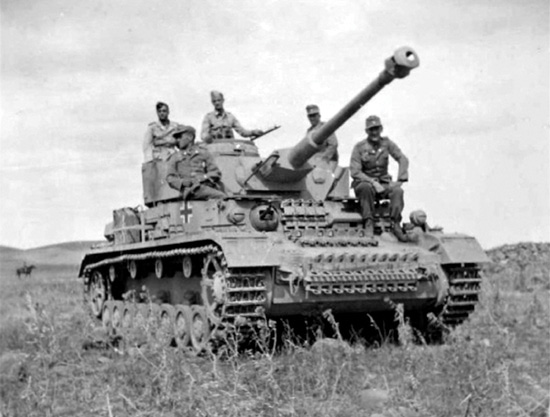
This seems to be an Ausf G fitted with the new muzzle brake, which went into production from May 1942. The Schürzen spaced armour on the turret was introduced in early 1943 along with spaced side skirts in response to a new type of Soviet anti-tank grenade.

A disabled Ausf H captured during the British advance on Villa Grande, Italy in 1943. Note the new design of single-piece hatch on the cupola. The engine silencer around the exhaust has been badly damaged. The tank has also thrown its left-hand track.
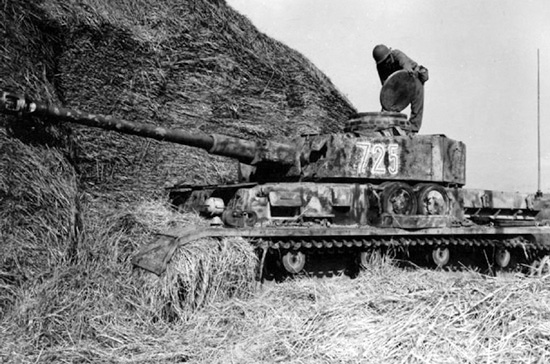
This abandoned late-production Ausf G or early Ausf H ‘725’ was found hiding in a haystack near Szee, Italy. Modifications during the H production run included deleting the side vision ports for the driver and radio operator – this vehicle still has them fitted.
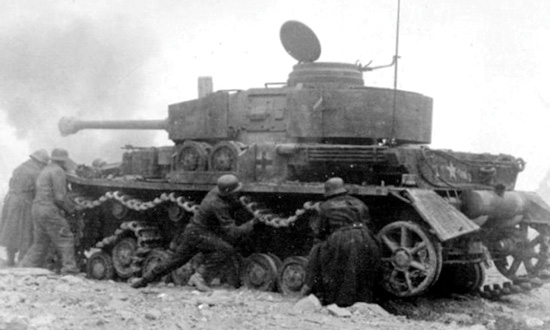
The crew of this Ausf H are repairing the tracks during the fighting at Monte Cassino in early 1944. They have left the doors open on the turret Schürzen to enable them to jump back in quickly if they come under fire.
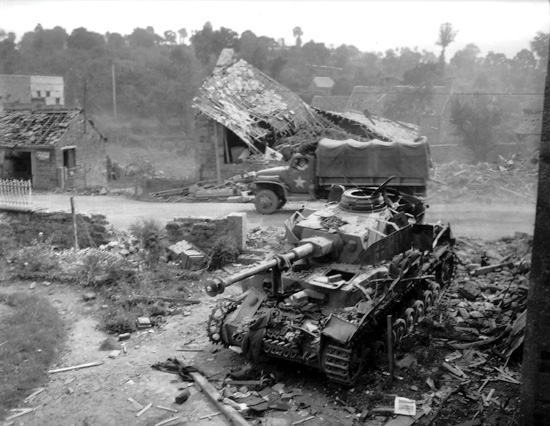
Ausf H ‘802’ serving with the 2nd Panzer Division was destroyed at Pontfarcy in Normandy. It has no Zimmerit and although the rail is fitted, the hull Schürzen is absent. At the beginning of June 1944 the division had ninety-four Panzer IVs.
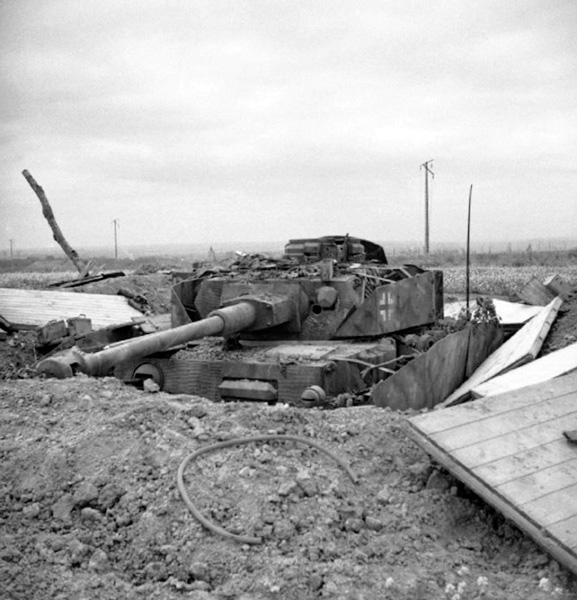
Belonging to the 21st Panzer Division, this Ausf H was knocked out on the plain north-east of Caen near Lebisey in June 1944. This tank was fighting ‘hull-down’ desert-style and appears to have been further concealed by the surrounding boards. Good shooting penetrated the turret’s 50mm armour. Zimmerit can be seen on the front of the superstructure and the turret.
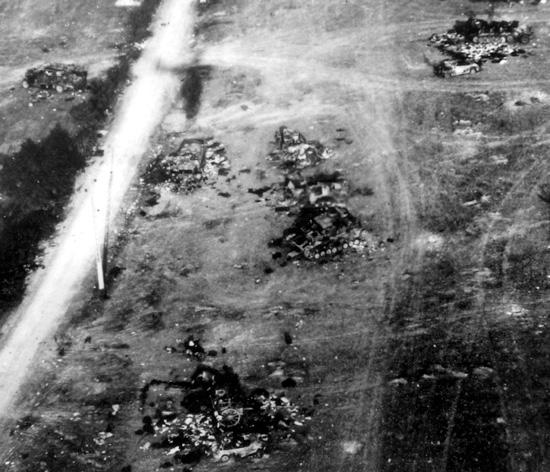
Remains of a burnt-out Panzer IV along with other vehicles caught in the open by Allied fighterbombers in Normandy.
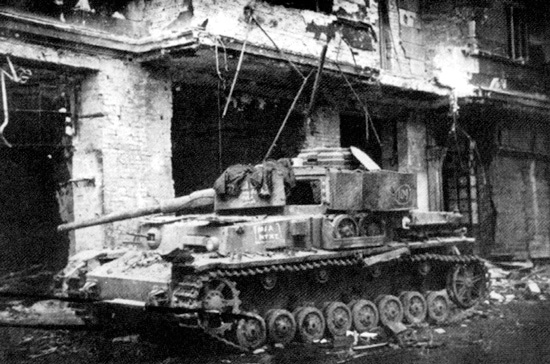
This derelict Ausf H, most likely from the 13th Panzer Division, was lost during the siege of Budapest in early 1945. The gun lacks a muzzle brake.
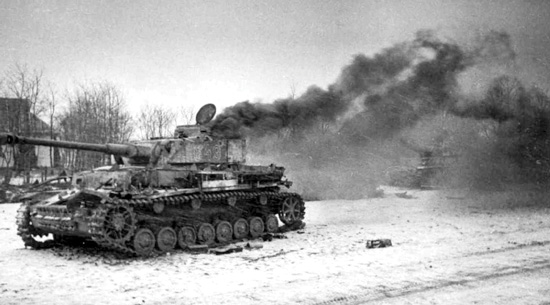
Two Ausf H burning on the Eastern Front: the second one is just visible through the smoke on the far right. Smoke from the nearest is pouring from the side of the turret, indicating a fighting compartment fire.








